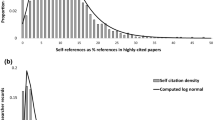Abstract
Citation counts often are used to measure scientific accomplishment. It is very difficult, however, to compute accurate citation counts in research where one has a list of scientists but not their complete bibliographies. At the same time, procedures are available that permit informed judgments about whether given scientists were cited at all in given years. The possibility of such judgments suggested that the number of years in which scientists were cited might be used as an alternative measure of scientific accomplishment. This possibility was explored in two studies, one based on 2,713 population scientists and the other on 135 articles published in the journalFertility and Sterility. Years cited was easy to compute, and had good descriptive statistics, satisfactory generalizability coefficients, high correlations with total citation counts, and distributions little influenced by outliers. These results supported the appropriateness of the years cited measure.
Similar content being viewed by others
References
J.R. Cole, S. Cole,Social Stratification in Science, Chicago, Illinois, University of Chicago Press, 1973.
F. Narin,Evaluative Bibliometrics: The Use of Citation Analysis in the Evaluation of Scientific Activity, Cherry Hill, New Jersey, Computer Horizons, Inc., 1976.
K.E. Clark,America's Psychologists: A Survey of a Growing Profession, Washington, D.C., American Psychological Association, 1957.
W. Dennis, Productivity among American psychologists,American Psychologist, 9 (1954) 191.
C.R. Myers, Journal citations and scientific eminence in contemporary psychology,American Psychologist, 25 (1970) 1041.
A.E. Bayer, J. Folger, Some correlates of a citation measure in science,Sociology of Education, 39 (1966) 381.
T.A. Brooks, Private acts and public objectives: An investigation of citer motivations,Journal of the American Society for Information Science, 36 (1984) 223.
J.S. Long, R. McGinnis, P.D. Allison, The problem of junior-authored papers in constructing citation counts,Social Studies of Science, 10 (1980) 127.
J.M. Richards, Jr., Structure of specialization among American population scientists,Scientometrics, 6 (1984) 425.
J.M. Richards, Jr., Patterns and correlates of research productivity in population scientists, ERIC Document Reproduction Service, Document No. ED 295 083, U.S. Department of Education, Washington, D.C., 1987.
B. Martin, On the neglect of scientists with low research productivity,Science, Technology, & Human Values, 15 (1990) 120.
T. Kuhn,The Structure of Scientific Revolutions, 2nd Edition, Chicago, Illinois, University of Chicago Press, 1970.
Population Association of America,1980 Directory of Members, Washington, D.C., PAA, 1980.
J. Cohen,Statistical Power Analysis for the Behavioral Sciences, Revised Edition, New York, Academic Press, 1972.
L.J. Cronbach, G.C. Glesser, H. Nanda, N. Rajaratnam,The Dependability of Behavioral Measurements: Theory of Generalizability for Scores and Profiles, New York, Wiley, 1972.
SPSS, Inc., Reliability, in:SPSS-X Users' Guide, Chicago, Illinois, SPSS, Inc., 1988, p. 872–889.
D. De Solla Price,Little Science-Big Science, New York, Columbia University Press, 1963.
P.F. Wernimont, J.P. Campbell, Signs, samples, and criteria,Journal of Applied Psychology, 52 (1968) 372.
R.K. Merton, The Matthew effect in science,Science, 159 No. 1 (1968) 56.
P.D. Allison, J.S. Long, T.K. Krauze, Cumulative advantage and inequality in science,American Sociological Review, 47 (1982) 615.
R.L. Helmreich, J.T. Spence, W.E. Beane, G.W. Lucker, K.A. Matthews, Making it in academic psychology: Demographic and personality correlates of attainment,Journal of Personality and Social Psychology, 39 (1980) 896.
S.P. Turner, D.E. Chubin, Chance and eminence in science: Ecclestiastes II,Social Science Information, 18 (1979) 437.
Author information
Authors and Affiliations
Rights and permissions
About this article
Cite this article
Richards, J.M. Years cited: An alternative measure of scientific accomplishment. Scientometrics 20, 427–438 (1991). https://doi.org/10.1007/BF02019763
Received:
Issue Date:
DOI: https://doi.org/10.1007/BF02019763




